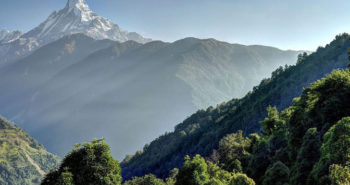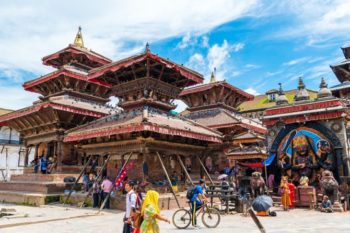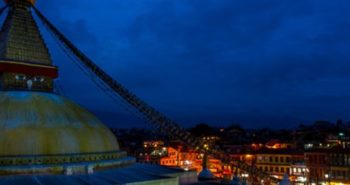How Difficult is it to Trek the Manaslu Circuit Trek?
Manaslu Circuit Trek is known for having fewer tourists, wandering landscapes, and amazing Buddhist culture. But Is this trek suitable for everyone? How difficult is the Manaslu circuit trek? Can it be done by a healthy person? Does it require additional training? In this article, we will dive into the Manaslu Circuit trek difficulty.
Situated within the Manaslu Conservation Area Project (MCAP) this trek goes through an area protected by the National Trust for Nature Conservation (NTNC) and thus sees fewer trekkers than some of the more established treks.
Often it feels like you are on an expedition into uncharted territory rather than a commercial trek, and it is for this reason, and others, that Manaslu Circuit is known as a ‘Challenging trek’.
What is a Challenging Trek?
If you take a look at treks in Nepal you will notice they are marked ‘easy’, ‘moderate’, ‘difficult’, or ‘challenging’. But what does that mean exactly? and Why the Manaslu Circuit trek is known as a “Challenging trek”
What is ‘easy’ to one person may be ‘difficult’ for another of course. But these ratings indicate how a t and active person will nd a particular trek. It also takes into account the lay of the land – such as the type of trails, number of days involved, number of trekking hours per day, etc.
Here we will try to provide you with details of what to expect in terms of difficulty on the Manaslu Circuit Trek.
So, What Makes the Manaslu Trek Challenging?
The answer to this question may not be what you think! Let’s take a closer look.
Personal Fitness for Manaslu Circuit Trek
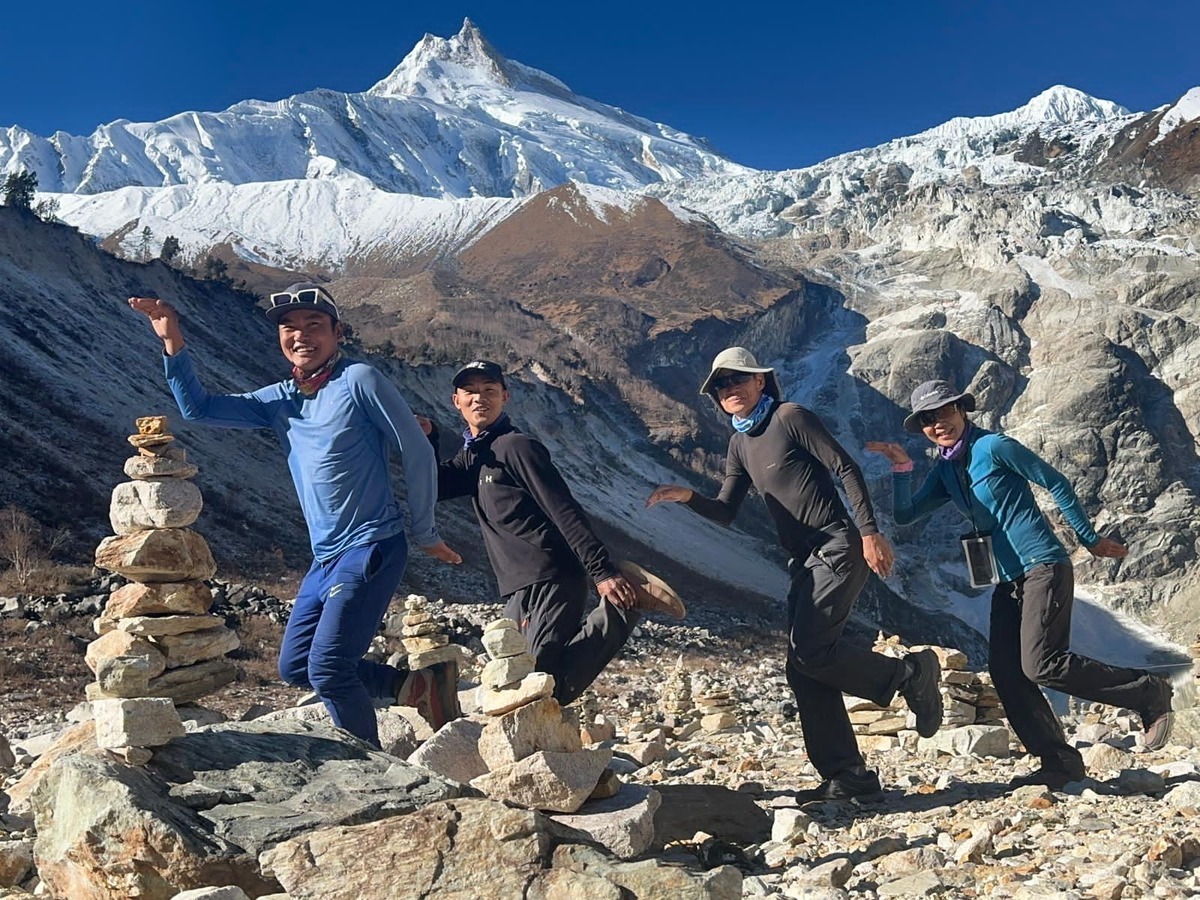
Let’s start with the basics. You need to have a certain level of fitness to trek in Nepal. That said, there are plenty of treks suitable for novice hikers, or family groups. Manaslu circuit is not one of them. And we know this how?
When choosing a trek, take a look at the altitudes you will reach and the number of hours you will be walking per day. You might hike for 8 hours in your home country at an elevation of, let’s say, 500 m/1640 ft above sea level, then head for a night out in a club. That amount of energy will have disappeared when trekking at say, 4,500 m / 14.763 ft!
On the 13-day Manaslu Circuit trek you are spending seven days above the height when we humans may begin to feel the effects of altitude: that is anything above 3,000 m / 9,842 ft.
We will explain more about altitude and its possible effects on the body. But, we are sure you are beginning to get the picture. But on the bright side, you start a manaslu circuit trek from 800 m/ 2624 ft and slowly gain around 300 m/984 ft a day which acclimatizes your body for altitude sickness.
Magical Nepal has two acclimatization day (Samagaun and Samdo) which helps your body to acclimatize for Larke la Pass.
Additionally, There are porters to make your manaslu trek more enjoyable and less difficult. Porter is optional but you can add Porter when booking the trip. It makes your trip more easy
How Fit Do you Need to Be to do the Manaslu Circuit Trek?
It is very important to increase your fitness before the trek. Most of you are probably now thinking of increasing the time in the gym. While this is a good idea, a treadmill will never take the place of walking uphill, and downhill, on rough terrain.
Gym equipment is designed not to injure you (unless you are careless) whereas trekking trails do not play by these rules! As long as you are a healthy weight you can still prepare yourself in advance, even if you don’t currently do much regular exercise. Give yourself one or two months (preferable) when you exercise for one to two hours a day.
Hiking on rough ground before you come will stand you in much better stead. And wear a day pack while doing it to replicate life on an actual trail. Don’t forget to wear your hiking boots too, yes, even on hot days!
But if you do not live in the Alps or Andes, how do you replicate hiking at altitude? Well, you most likely can’t but what you can do is increase your lung capacity through cardio exercise.
Do you need to be Young to do the Manaslu Circuit Trek?
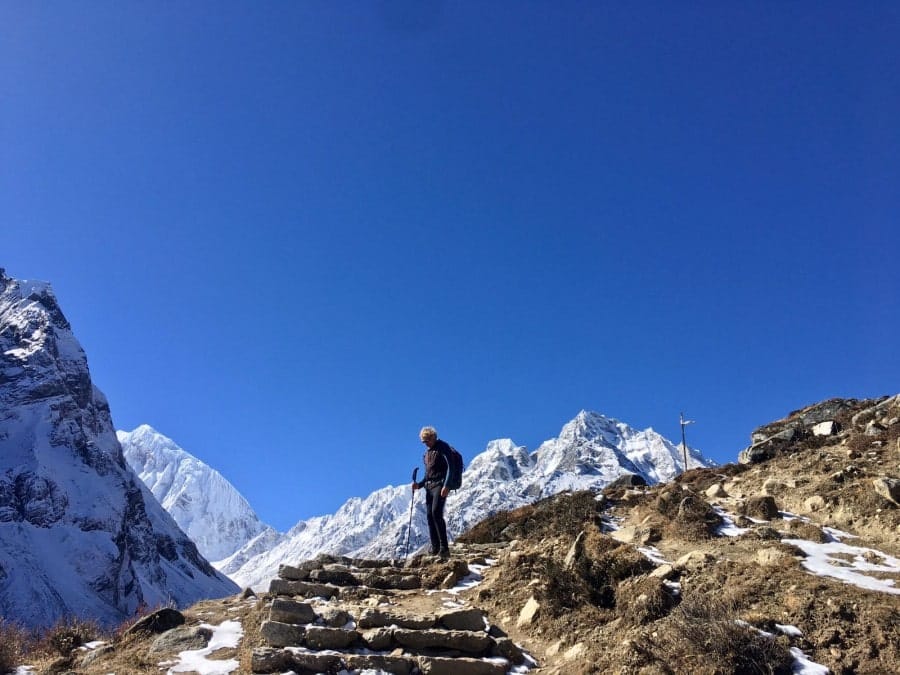
As long as you are of good health and physical fitness you can do this trek even in your mid-life.
We at Magical Nepal have had clients in their 50s, 60s, and even 70s who have completed and thoroughly enjoyed this trek. Manaslu circuit is a difficult trek but completely doable. We have designed an itinerary that suits all age groups. If you are not sure and still want to know your ability to conquer the Manaslu circuit, contact us. We would love to guide you and prepare the best itinerary for your needs.
As mentioned above, it is important to prepare for this trek and to know your own body’s capacity.
What are the Distances and Altitudes in the Manaslu trek that I have to conquer?
Let’s take a look at why you are increasing your fitness and working on your lung capacity.
How far and at what elevation you travel each day will affect your body greatly. And don’t forget that steep rises and falls in altitude also take their toll.
The Manaslu Circuit Trek starts from Kathmandu, which lies at a mere 1,400 m/4,593 ft. We say merely because Kathmandu lies in a valley and unless you are in the Terai (south Nepal) where the altitude is around 300 m /984 ft, Kathmandu is considered low. For Nepal that is. Consider the fact the highest mountain in the UK, Ben Nevis in Scotland, stands slightly less high than Kathmandu!
On the first day of this trek, you drop in altitude to 930 m / 3,051 ft at Maccha Khola, where the trek starts properly. On Day 9 you reach the highest point – 5,000 m / 16,404 ft up near the Tibetan Border. This is an acclimatization day before you head over the high Larkya Pass at around the same height!
Daily Distances and Altitudes in Manaslu Trek
Firstly, let’s take a closer look at the distances and altitudes for each day of the Manaslu trek. You can make a sense of the Manaslu circuit trek difficulty level based on this data.
As mentioned, on
Day 1: Kathmandu to Macha Khola Drive:
Difficulty Level: This is just a driving day. You just sit in a bus or Jeep and go to the trail start point. This is a fairly easy day.
You decrease in altitude. This involves a seven-hour drive from Kathmandu to the town of Maccha Khola from where the trek starts the next day.
The following day,
Day 2: Macha Khola to Jagat
Difficult Level: Difficult
You get back up to a height similar to that of Kathmandu as you walk along the banks of the Budi Gandaki River and forest trails. Although the trail is relatively straightforward so far, and the whole day will see you walk for around 5 to 6 hours at a low altitude, we recommend you save some energy for a three-hour difficult climb at the end of the day. If it wasn’t for the thought of that climb we might recommend a soak in the hot water springs at Tatopani. In addition, there are the mental challenges (of which we will speak more of soon) of a swaying suspension bridge and a landslide-prone area to cross.
Days 3 and 4: Jagat to Deng to Namrung
Difficulty Level: Difficult
are still at low altitudes and both of 5 to 6 hours of walking. Now in the restricted area, so called because of its closeness to the Tibetan border, the trail is still heading along rivers and forests of pine and rhododendrons. Unfortunately, there are more landslide areas to negotiate making part of the trail mentally and physically challenging. And another suspension bridge, worrisome to a few folks only perhaps. Uneven trails that zigzag upwards are also a feature that often makes us concentrate on our feet and forget to look up at the beauty around us. Frequent photo breaks (and to catch one’s breath) are recommended!
Day 5 and Day 6: Namrung to Lho to Samagaun
Difficulty Level: Easy
On this trek, you are now at ‘altitude’ i.e., high enough to begin to feel something – maybe a headache? Keep an eye on that and keep your pace slow and steady. Both these days involve 4 hours of walking, again through forests and over relatively ‘easy’ trails. You will have noticed the influence of Tibet by now in the dress and culture of the local people. By the time you reach your accommodation on Day 6, you see yak pastures and perhaps a few of these sturdy beasts.
Now everyone is likely to be feeling something a little bit not quite right. A headache, diminished appetite, more tired than you ought to be – if these feelings become unmanageable it is time to take action. This is why
Day 7: Acclimatization day at Samagaun: Hike to Manaslu Base Camp
Difficulty Level: Challenging
is known as an acclimatization day. These days are normal while trekking in Nepal and are built into all higher-altitude treks. Acclimatization is vital when trekkers venture higher in altitude but is not to be confused with ‘rest days’. The best way to acclimatize is to keep moving, be active, and remember why you are doing this trek – for the beauty of the countryside. On this trek, Day 7 consists of a trip to Manaslu Base Camp or to Pungyen Gompa (a Buddhist monastery). This will take up the whole day, around 7 hours. The paths will not be easy, but the views are worth the long hike.
Don’t be fooled by the advertised 2 to 3 hours trek on
Day 8: Samagaun to Samdo
Difficulty Level: Difficult
Although you will be dropping down in altitude, from 4,400 m / 14,435 ft at Sama Gaun to 3,865 m / 12,680 ft at Samdo, you are walking above the tree line, through yak herders’ homelands, and the going is physically tough.
Thankfully there is another acclimatization day at Samdo on
Day 9:Acclimatization day at Samdo
Difficulty Level: Challenging
But it does involve an 8-hour hike to the Tibet Border. The reward is, along with keeping healthy, the wonderful Samdo Glacier you will see.
Day 10: Samdo to Dharamsala
Difficulty Level: Difficult
is another day at high altitude as you drop down 440 m / 1,443 ft to Dharmasala sitting at 4,460 m / 14,632 ft. Here the trail is rugged, but the Himalayas are strung out in front of you so remember to stop and look up!
Day 11:Dharmasala to Bhimthang
Difficulty Level: Challenging
can be considered one of, if not the highlight of the trek! Now this is what we call challenging! The Larkya La Pass lies at 5,160 m / 16,929 ft and must be crossed in the morning before the high winds set in in the afternoon.
All in all, it takes 10 hours of hard trekking today, made harder by that early morning – around 3 am – rise. We hope for good weather as bad weather, including snowfall, makes things all the more challenging. The final three hours of the day are spent going downhill (knees!) to reach Bimthang. Today the views are of Pongkar Lake, Pongkar and Salpu Danda Glaciers, and several incredible high mountains in the Annapurna Range.
Finally, the trails come back to rhododendron bushes, and agricultural fields on
Day 12: Bhimtang to Dharapani
Difficulty Level: Easy
As the trail drops from 5,160m / 16,929 ft to 1,970 m / 6.463 ft at Dharapani, you can certainly feel the difference. Breathing becomes much easier on this last 7-hour day trek. But as you can imagine, there are a lot of downhill sections to deal with.
Day 13: Dharapani to Kathmandu: involves no trekking but a simple 10-hour drive back to Kathmandu.
Diculty Leve: Easy
Mental Fitness for Manaslu Circuit
We don’t mean you need to be an Elon Musk or Albert Einstein to do the Manaslu Circuit Trek. We mean you should be prepared to meet some of the hardships and challenges that you will encounter on the way. And not every trekker will see the same adversity as a mentally challenging one. It will vary from person to person.
What do we mean exactly? Let’s look at some examples.
How difficult is it to get Accommodation in Manaslu Circuit:
Trekking lodges in Nepal are called ‘Tea Houses’. Which straight away should give you a pretty good picture of what to expect. If you are a hiker in the UK, you can think of a teahouse as a bothy where you don’t need to cook for yourself, but you do need to pay for your overnight stay. Rest of the world, we cannot, and if you have anything similar to a bothy (a building with basic amenities where you can stay overnight in the British hills and moors). But back in Nepal – a Tea House is usually family-run, simple accommodation consisting of twin rooms or dormitories.
Menus vary depending on the trek. On the Manaslu Circuit Trek, the menu will be quite basic, with more Nepali and Tibetan dishes than Western ones, but tasty and filling. The downside is that there are no attached bathrooms – toilets and showers are shared. You may be unlucky (think of those knees again!) and have a squat toilet in your teahouse. Sleeping rooms are not heated, although the dining room will be.
Is it difficult to get a variety of food in Manaslu Circuit Trek
This is a more remote trek so you should be prepared to eat local food. Although there is a wide variety of food available now. Thanks to the growing expedition to Manaslu.
There are a couple of settlements in which good coffee and some bakery items have arrived, but on the whole expect to eat curry, fried rice, fried noodles, Tibetan noodle dishes, etc. If this is too much for you, you can always order eggs and toast for dinner as well as for breakfast.
Fried potatoes are also a more familiar dish to most people. Tea is plentiful and there will be bottled soft drinks as well.
How cold can it get? Is it difficult to tackle cold if I live in a hot climate zone?
Life is not a beach when trekking in Nepal! Even if the days are warm and sunny, the temperature drops considerably in the night. This will vary depending on the season, but it will be cold at some point, and you should prepare both physically (plenty of warm layers) and mentally for the cold!
Cleanliness:
Whether it’s your own or your surroundings, sometimes if best to turn a blind eye. We even the most fastidious person do not shower every day on a trek. Wet wipes are a great idea (please take them away with you also for proper disposal if they are not biodegradable).
Having your sleeping bag will get around any doubts about the cleanliness of the bedclothes. Rest assured the food served will be hygienic as everyone, even in the most remote parts of the country, understands that.
Blisters:
Ensure you wear your trekking boots a lot before you arrive in Nepal. Bring blister pads. You may wish to consider bringing a small first aid kit with you.
How difficult is the overall Trail:
If you haven’t crossed a suspension bridge before, you might nd it a little alarming! It may swing back and forth a bit and it may be high above the river or gorge below! Landslide-prone areas are more of a real danger than suspension bridges. Listen to what your guide tells you – he will know the best way to cross safely. Just keep your nerve and trust your feet.
Fear of altitude-related or other illness: As long as you are physically before your trek keep hydrated and go at a steady pace… remember thousands of trekkers come to Nepal every year and it is only a small number that get into serious difficulties.
Altitude sickness can be a real threat, and you should listen to your body, tell your guide if you are unwell, and if necessary (on your guide’s advice) go downhill. See below for more details. The worst-case scenario is being taken out by helicopter. This reminds us to mention a good insurance policy!
On a final note, there are two acclimatization days built into this itinerary which will help you acclimatize and prevent altitude problems. Despite the fact it is a challenging trek, due to the fact you rise around 300 m / 984 ft per day, your body is given time to adjust and again this lessens the chances of altitude-related problems.
Culture shock in Nepal: It’s not the first time we have seen visitors in Nepal and other countries who are paralyzed by culture shock on arrival.
The noise, the crowds, the smells, and just the whole feeling of being a shout of water are just too much for some. This will settle down after a couple of days, especially if you have someone (like our guides) who can explain a little of the culture to you.
How difficult is it to travel in Local transport: we don’t like local transport either, we have to confess. But in some areas that is all there is. If this is a deal breaker, private jeep hire is available should you wish to pay for that. Definitely more comfortable but then you miss out on part of the experience and fun with locals.
Altitude Sickness in Manaslu Circuit
There is a lot written about altitude sickness, particularly as each season there are deaths on mountains such as Everest and K2.
What starts out as a headache, fatigue, insomnia, and nausea can end as vomiting, confusion, loss of consciousness, dizziness, and death. It is not to be taken lightly.
High altitude cerebral edema (HACE) is the most dangerous and can appear in people with acute mountain sickness who are traveling at high altitudes – it is usually HACE that takes the lives of mountaineers.
What is altitude sickness?
When your body cannot get enough oxygen you will see signs of altitude sickness. This happens to people who go high too quickly, and/ or are not used to high altitude.
At what height can you get altitude sickness?
Technically, humans can suffer from a lack of oxyhemoglobin at an altitude of 2,100 m / 6,889 ft. But it is more likely to happen at altitudes of around 3,500 m / 11,482 ft and above.
How to avoid altitude sickness in Manaslu Circuit Trek
Some people take Diamox tablets, which must be obtained from your doctor before you come to Nepal.
But more generally, do the following: Acclimatize
Do not drink alcohol or smoke on the trek Drink plenty of water
Do not go up in altitude if you have any symptoms
Go down if you continue to feel unwell.
Always report symptoms to your guide even if you think they are mild
And remember, on the Manaslu Circuit Trek there are two acclimatization days and a relatively low increase in height each day. Both of which help reduce risks.
Seasonal Difficulty and Best Time to Do This Trek for Manaslu Circuit
Like the majority of treks in Nepal, the best seasons to do the Manaslu Circuit Trek are in the spring (March – to June) and autumn (mid-September to mid-November). At these times of year, the weather is clear and the mountain views are outstanding.
We do not recommend trekking in the monsoon (summer months) as the trails become slippery and it is hard to predict when heavy rain will fall, making it impossible to trek during that time.
Similarly, while the winter provides a different feel to trekking, we do not recommend the Manaslu Trek at this time due to the very real possibility that the Larke Pass will be closed. Or at least extremely difficult to cross.
If you can only come to Nepal during the winter or summer seasons, please ask us about alternative treks.
Add Porters on Manaslu Trek to make your Manaslu trek more enjoyable
Circling back around to personal fitness, what will make your trek less stressful and allow you to fully enjoy your surroundings is hiring a porter. These amazing guys can do astonishing feats of carrying stuff up and down in the mountains without complaint. But let’s not add to any burden – we tell clients that each porter can carry up to 20kg and that if you keep your bag to under 10kg, you can share the cost of the porter with not
